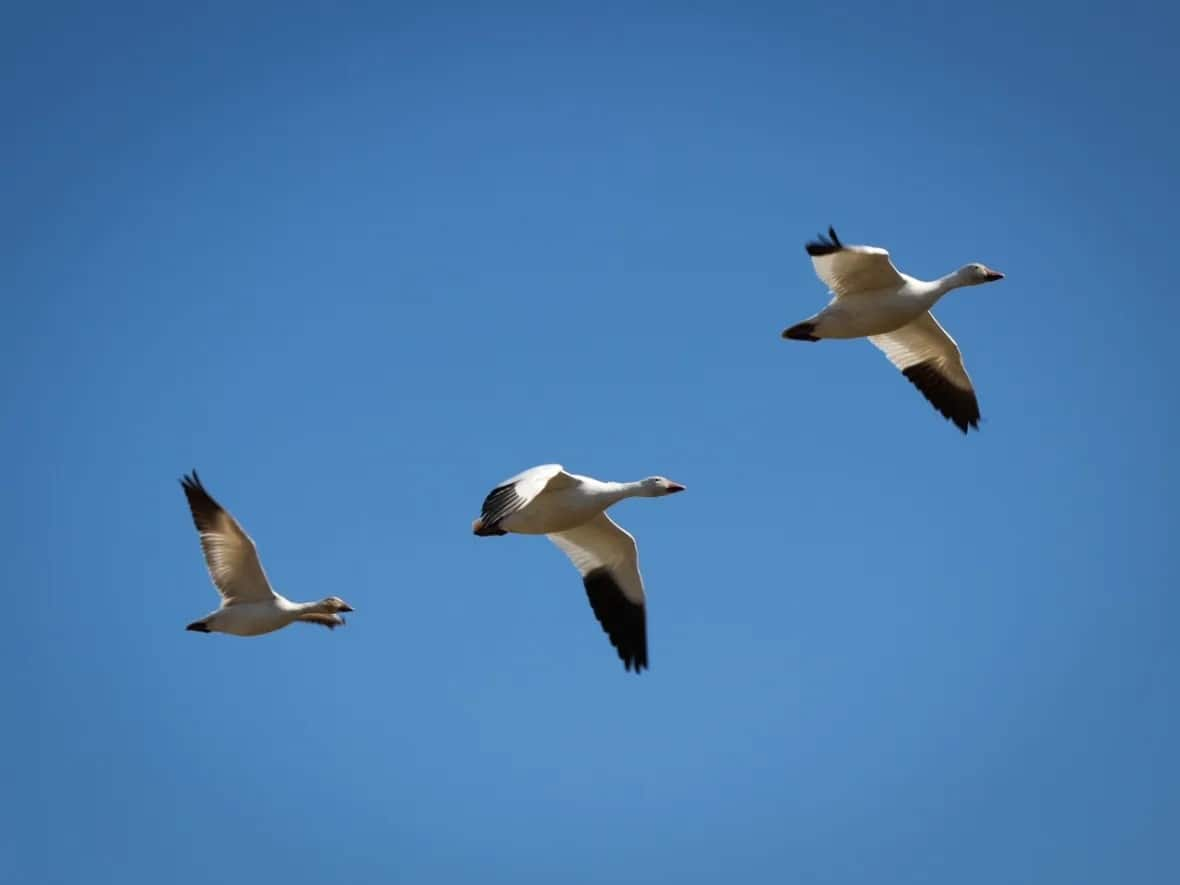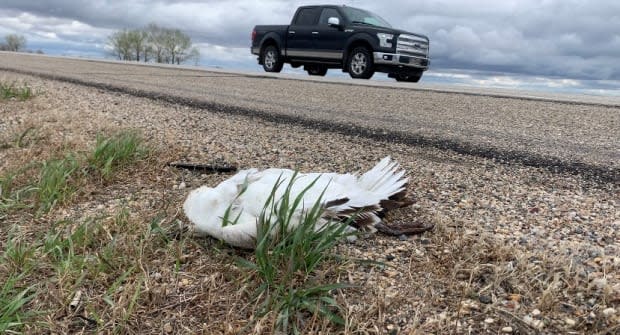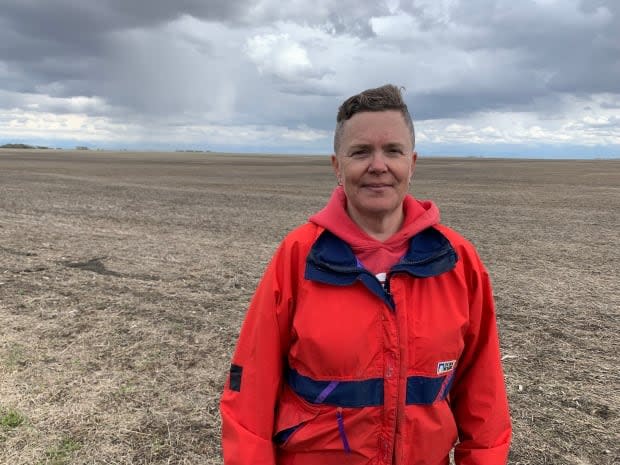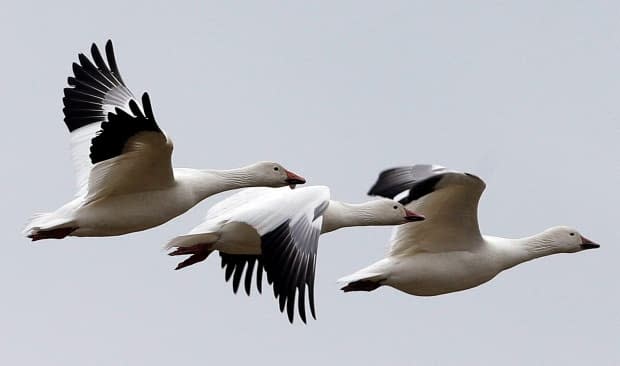Hundreds of snow geese expected to have been killed by avian flu in Saskatchewan

Jen Gibson is a self-proclaimed bird geek who always looks forward to seeing snow geese in the spring.
But this year when the birds passed by her property near Grand Coulee, about 20 kilometres west of Regina, she noticed that something was wrong.
"I have never seen this number of dead birds," said Gibson, who has lived in the area for almost 15 years.
It's not an isolated problem. In Saskatchewan and across the country, snow geese have been hit hard by an avian flu that is killing them.

Since early December, a highly contagious form of avian flu has been ravaging migrating birds in Canada, said Iga Stasiak, a wildlife health specialist with the government of Saskatchewan.
"This is the first outbreak in Saskatchewan since 2007," Stasiak said, adding this particular strain of avian flu, H5N1, has been very aggressive.
"It has caused more significant mortality, and we've seen a much broader breadth of species impacted than we have with previous strains.
Bird reports
"Since late March the province has received over 300 reports of ill birds or mortality," she said, adding there are 100 presumptive positive cases awaiting confirmation.
The birds usually die within a week of getting infected. Avian flu is generally associated with a respiratory virus, but this strain is "affecting multiple organ systems, including the liver, the kidneys, the pancreas and the nervous system, including the brain," Stasiak said. They have noted neurological symptoms in the birds, including tremors and jerking movements.

The majority of cases have been concentrated in the south-central zone of the province, with the bulk of the infected birds being found in communities, such as Grand Coulee, along the Trans-Canada between Regina and Moose Jaw.
"In that region, the birds are stopping over along their migration routes and that's where you're seeing the very large flocks of birds," Stasiak said. Some sick birds have been reported as far north as Nipawin, 360 kilometres north of Regina.
Snow geese migrate annually from Texas.
"[They] pass through the southern United States and then they fly up all the way up into the Arctic to their nesting grounds," making the infection rate widespread, Stasiak said.
She said most of the snow geese have made it to the north now and people are probably seeing dead birds because the snow has melted.
That's when Gibson really started to notice the problem.
She said the migratory season started just like any other year.
"They settled in the field and everything seemed fine. And then when they left and the snow started to melt, it became clear that there was some that didn't make it. I would say at least a dozen, if not more."
Fields of birds
At first she thought the deaths were due to in-flight collisions, but after some research she discovered they had most likely died from avian flu.
"I was heartbroken to see them so affected by avian flu," Gibson said.
Her property wasn't the only one with dead birds dotting the fields. It was clear the issue was widespread through the community.

"You could see them off the highway," she said. "You could see them around Grand Coulee. And then, you know, once they left, you could see that there were some that didn't make it."
Stasiak said the avian flu was first detected on the East Coast. It's believed to have spread across the Atlantic seaboard into the Midwestern states and then north with the birds in the spring migration. This has meant widespread infection across the Prairies and west to British Columbia.
"We're seeing similar reports of mortality across the country," she said.

Snow geese are an abundant species and "it still seems to be a relatively low proportion of the population that's been impacted," Stasiak said.
Spreading to other species
Initially, Stasiak's reports showed the virus was only impacting snow geese and Ross's geese, but it has spread to other species.
"We are also getting quite a few reports in raptor species. So hawks, eagles, great horned owls, also scavenging birds, so crows, ravens and magpies." She suspects these birds are likely feeding on infected waterfowl carcasses and getting infected.
While no cases have been reported of scavenger mammals being infected with the virus yet in Saskatchewan, Stasiak urged property owners to remove any dead birds that could be consumed by family pets.
She recommended wearing a mask and gloves and using a plastic bag to pick up the bird, then double-bagging it before disposing of it.
One dead bird can go in household waste, but if there are more they need to go to an approved landfill, Stasiak said.
But as a rule, she recommended leaving the birds where they are and letting them decompose naturally.
Tracking diseased birds
Stasiak said the province is relying on members of the public to report any birds that are exhibiting unusual behaviour or that appear to be sick.
While they can't help infected birds, the department wants to know where they are, because "this will be vital in understanding the extent of the virus and its impacts."
Officials are also trying to learn "if there are birds out there that are carriers or not showing any clinical symptoms."
Sick and dead bird sightings can be made through the provincial inquiry line, the Canadian Wildlife Health Cooperative, the Wildlife Health Tracker app, or by calling the wildlife emergency hotline on 1-800-567-2033.

 Yahoo Movies
Yahoo Movies 
